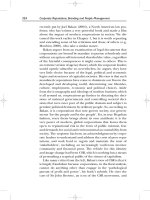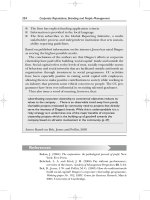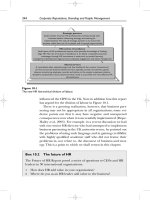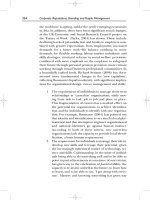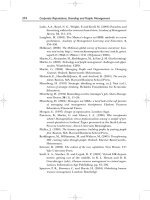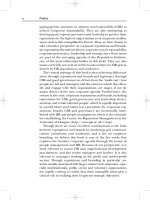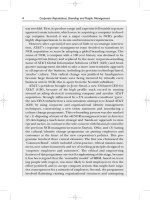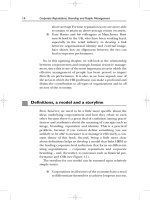Tài liệu Corporate Reputations, Branding and People Management 11 ppt
Bạn đang xem bản rút gọn của tài liệu. Xem và tải ngay bản đầy đủ của tài liệu tại đây (124.05 KB, 10 trang )
chapter. As HRM specialists or boards of directors, we probably
have a greater chance of managing at the organizational identity
level because we have more control over its key elements and
drivers (e.g. its distinctiveness from other organizations) than
managing identification at the individual level. This is because
individual identity remains the property of individuals and is
driven by how they see themselves, not how they see the organi-
zation. Individual identity is thus more diffuse and difficult for
others to control (Sparrow and Cooper, 2003).
84 Corporate Reputations, Branding and People Management
Identity (an
organizational
cause)
Identification
(an individual
effect)
REPUTATION
Explanation Justification
Figure 3.2
Identity as a cause and identification as a justification (based on
Whetten and Mackey, 2002, p. 407).
Two examples serve to illustrate why this might be the case.
The first arises from some research we have conducted on the
impact of information and communications technologies (ICT)
and HR. Many organizations use web-based HR portals to create
a corporate feel (organizational identity) in their organizations.
Not only are such portals seen to lead to a more corporate iden-
tity, but, once in place, are used to justify further investment in
e-HR to promote employee self-service for HR services and have
line managers take on more responsibility for people manage-
ment. However, there is evidence that some employees and line
managers perceive this process as little more than cost-cutting;
even worse, it causes them to re-evaluate their traditional rela-
tionship with HR as a de-personalized one, in turning reducing
their individual identification with the organization. So although
the understanding of who we are may be advanced, the levels of
identification may decline because the interests and perceptions
of some individuals are not seen to coincide with the organiza-
tional aims of self-service.
The second example is from research conducted by our close
colleagues Judy Pate and Phil Beaumont into a public sector
organization responsible for environmental protection. In this
organization there are many professional scientists with high
levels of qualifications and external interests/affiliations. Some
of these professionals agree with the overall values of the organ-
ization and understand ‘who we are’; however, some individuals
identify more closely with their professional careers and in their
answer to the question ‘Who am I?’ is more wrapped up with
their personal identity as a scientist. Many years ago, the sociol-
ogist Alvin Gouldner (1954), described this conflict in terms of
the relative strength of different kinds of loyalty to firms – the
‘cosmopolitan’ expert, whose power and interests are linked to
their technical expertise and the ‘local’, true bureaucrats, whose
power and interests are linked more closely with the traditional
administrative bureaucracy and agenda of organizations. The
critical point of this analysis is that, in modern organizations,
experts are always subordinate to the bureaucracy and bureau-
crats, and are likely to experience tensions in being subordi-
nated. As a result, they perceive their interests are often best
served by enhancing their technical expertise, sometimes at the
expense of the corporate agenda; in turn, this self-centred or
self-interested behaviour is often reinforced by the approach of
organizations in tearing up the old, relational, employment
deal and replacing it with a new, more transactional deal (see
Chapter 4 on psychological contracts).
This work by Gouldner foreshadowed the current concern
with knowledge workers and their attachments to organiza-
tions; it is also relevant to the often-experienced role conflict
arising from the competing pressures of HR to become stra-
tegic partners by their organizations and their, some would say,
natural inclinations to act as employees’ champions. Arguably,
the HR business partner model, so favoured by many com-
panies, is a compromise between these two claims for identifi-
cation, a concept we examine in the final chapter of this
book.
Let’s look at a case we researched for this book to illus-
trate some of the practical problems involved in the image-
identity relationship and the problems of managing across the
individual–organizational levels.
Chapter 3 Organizational identity, action and image: the linchpin 85
86 Corporate Reputations, Branding and People Management
Box 3.1 Image and identity problems at Scottish
Enterprise (adapted from Martin et al., 2005)
Scottish Enterprise (SE) is the major national economic development
agency for Scotland, the senior managers of which report directly to the
Scottish Executive (the civil service) and, through them, the Scottish
Parliament on issues such as economic growth, industry development. In
2004, SE employed 2500 people with a budget of £500 million per annum.
According to its website ( />home/about_se.htm?siblingtoggle ϭ 1; 28 February 2006), its key prior-
ities are to provide a range of high quality services to:
■ help new businesses get under way
■ support and develop existing businesses
■ help people gain the knowledge and skills they will need for tomor-
row’s jobs
■ help Scottish businesses develop a strong presence in the global
economy – building on Scotland’s reputation as a great place to live,
work and do business.
SE developed from 14 relatively autonomous local enterprise councils
(LECs) that had served the regions of Scotland during the 1980s and
early 1990s. Whilst having a common charter, each of these LECs had
its own ways of doing business, its own cultures and internal identities
and own external images. As such, there was a great deal of confusion
in the business community and among the general public about the
role of the LECs. For example, it was possible for individual businesses
to seek assistance from two LECs and be made quite different offers of
service and grants. In addition, the majority, though not all, of the
LECs interpreted their role effectively to exclude service to the large
organizations in their respective communities, instead preferring to
see themselves as the champions of the small and medium-sized enter-
prise (SME) sector. As a direct result, the LECs suffered in terms of
corporate reputation among the key 150 companies in Scotland, a con-
dition which was reflected and reinforced by damaging attacks by cer-
tain sectors of the business press that saw no useful role for public
sector organizations in essentially private business.
To make matters even more complicated the Scottish Executive
decided to have SE incorporate ‘Careers Scotland’, a previously autono-
mous branch of the Scottish Executive employing 1100 staff. The careers
service and many of the people who worked for it embraced an agenda
Chapter 3 Organizational identity, action and image: the linchpin 87
of social inclusion by championing the less successful people in society.
This social inclusion agenda and culture of the careers service have not
always sat easily with the more market-oriented, business-driven image
that SE sought to create.
In 2000, a new Chief Executive, Robert Crawford, put into place a
major exercise of corporate change to address these damaging image pro-
blems and the incorporation of Careers Scotland. This new, larger version
of SE was intended to provide a single shared service for economic
development for Scotland,
1
and for vocational training, career develop-
ment and international business development. As part of this change pro-
gramme, SE sought to reorganize internally to bring the LECs under
more close control but, at the same time, allow them substantial autonomy
in carrying out their regional economic development and training roles.
Such reorganization was also to be accompanied by a decision to make
substantial reductions in staff numbers and to introduce efficiency
savings in the operating budget of £50 million. The senior directors of
SE took the initial line that this strategy would need to be accompanied
by a strong corporate brand image and to have the LECs support that
corporate image in every aspect of their operations. To test their think-
ing, they set up a ‘Values and Brand’ team comprising two marketing
staff, two HR staff and five operational staff, each with different back-
grounds. Diversity of backgrounds of team members was seen to be
essential in configuring the team to reflect the make-up of the SE net-
work. The task they were given was to research the need for a corporate
brand image and to develop a brand strategy, for the period 2002–05, if
they sensed that external image and internal identity were a problem.
They were also asked to work and liaise with an HR-led group which was
researching into the need for culture change in the organization.
Early research commissioned by the team in 2000 showed the extent of
the problem faced by Scottish Enterprise in presenting a coherent image.
A total of 272 logos and 160 websites were being used throughout the
network of LECs. This lack of corporate coherence was reflected in more
subjective assessments of the multiplicity of sub-cultures, different iden-
tities of professional groupings and employment practices used through-
out the network. The people-management dimension of the problem was
made especially difficult given the simultaneous decision by SE to reduce
staff numbers from 2000 to 1500 to make efficiency savings of £50 million.
1
Except the Scottish Highlands and Islands, which was thought to be unique
enough to require its own economic development agency.
88 Corporate Reputations, Branding and People Management
Following the research phase, which had confirmed the initial expec-
tation that a unified corporate image and values framework would need
to be created for the transformed SE, the team began to realize that
they did not have the expertise to develop the strategy on their own. Con-
sequently, they sought advice from a leading academic in the field and
from a leading consulting organization to help them develop the brand
strategy. By January 2002, the team, in conjunction with the consultants,
had developed a coherent brand strategy and implementation plan,
comprising the following elements:
■ brand concept and values
■ brand personality tone and style
■ brand strategy objectives and targets, 2002–05
■ brand architecture and guidelines for the promotion of products
and services (including a comprehensive Visual Identities Audit,
the development of an online Intranet Brand Guidance Tool and
the creation of SE’s first comprehensive Visual Style Guide)
■ brand monitoring and evaluation framework
■ ‘Living the Values’ staff programme
■ internal communications plan
■ external communication priorities guidance.
Since January 2002, there has been a major effort to implement this
strategy, with cascaded workshops designed to communicate the brand
values as part of the ‘Living the Values’ staff programme and major
exercises in consultation with external stakeholders and employees
throughout the network on the external and internal brand image and
identity. One of the key features of the SE programme has been the sys-
tematic implementation of the brand monitoring and evaluation frame-
work, culminating in an annual brand strength report. This report tracks
progress against objectives through quantitative and qualitative research
on the external and internal aspects of the SE brand. The report has been
used as a starting point for an annual ‘conversation’ with the SE board
and throughout the network more generally on how to develop the exter-
nal corporate image and internal organizational identity. In 2003, the
following results, which give some indication of the progress that has been
made within SE, were reported:
■ Internal measures from the annual staff survey showed that the
composite ‘score’ on questions relating to employee understanding
